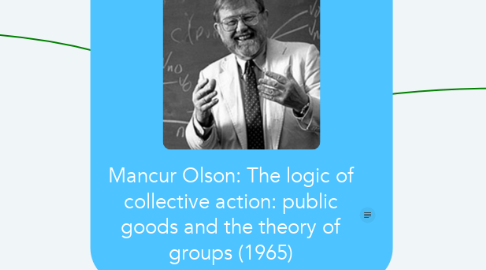Mancur Olson: The logic of collective action: public goods and the theory of groups (1965)
by Gresa Hajredini

1. Biography
1.1. Born in 1932 in Grand Forks, USA
1.2. Died in 1998, Maryland, USA
1.3. American economist and social scientist, big influence on political science and sociology
1.4. Studied political economy at University of Oxford; doctor's degree at Harvard University
1.5. Work: assistant professor at Princeton University; deputy assistant for United States Secretary of Health and Human Services in Washington D.C.; finally joined economics department at University of Maryland
2. Research question
2.1. Under what circumstances do individual members of a group act in favor of their group, so that the common interest is pursued?
3. Taxonomy of groups
3.1. 1. Small groups: they can provide themselves with collective goods without relying on other incentives beside the good itself -> most likely that the good is provided
3.2. 2. Intermediate groups: they are small enough so that the group members notice if anyone does not act collectively when providing the good; in such a group, the public good may or may as well not be provided
3.3. 3. Latent groups: very large groups; here, no one really notices whether someone helps providing the good or not -> only other incentives will make the rational group members act in a group-oriented way
4. "Exclusive" and "inclusive" groups
4.1. Whether new members are welcome highly depends on the situation in which a group is. For example, firms in a classic market competition usually oppose any kind of competition, associations supplying public goods usually welcome new members.
5. Critique
5.1. Rational Choice Theory: Is it appropriate to view individuals as completely rational, utility-maximizing beings?
5.2. His theory does not really have empirical foundation that he relies on. In terms of methodology, his approach was more of a theoretical consideration rather than an actual experimental design.
5.3. His logic of collective action has received multiple critiques. Based either on a different interpretation of the observations on minority interest representation, and on the other hand on a disagreement on the degree of concentrated interest representation
6. Basis: Rational Choice Theory & Methodological individualism
6.1. = Framework for understanding economic and social behavior
6.2. Common social behavior or social phenomena are a result of individual actors, who all make individual decisions
6.3. Individuals are rational, know their needs and have preferences among available choice alternatives
6.4. Individuals always decide in favor of their own interests (homo oeconomicus)
7. Traditional theory of groups:
7.1. Assumption, that private groups/ associations operate using entirely different principles from those of firms in marketplaces or the state
7.2. Casual variant: Forming groups/associations is a fundamental human propensity.
7.3. Formal variant: Groups are an aspect of modern society in contrast to primitive societies, who didn't form groups larger than families/households
7.4. Empirical research: shows that the average person is typically not a "joiner" --> forming groups is not in the nature of humans
8. Purpose of organizations
8.1. Consideration of organizations in a theoretical way: the purpose of an organization is the furtherance of the interests of their members
8.2. Patriotism as strongest non-economical motive for group formation
9. Public goods and large groups
9.1. Large groups/firms have both a common and an individual interest
9.2. Large groups, much like governments, cannot function without using some form of coercion to have members contribute financially
9.3. Individual interest of firms to maximize profits often conflicts with the profits of the industry as a whole, hence with their common interest
9.4. Free-rider problem: Once the common interest is achieved/ a public good has been provided, none of the group members can be excluded from using it -> some of them do not have an incentive anymore to act group-oriented, but rather follow their own interests
10. Bibliography
10.1. Olson, M. (1965). The Logic of collective action. Public goods and the theory of groups [Harvard economic studies. vol. 124.]. Harvard University Press.
10.2. Picture: https://upload.wikimedia.org/wikipedia/en/3/36/Mancur_Olson.jpg
11. Small groups
11.1. In small groups, a public good may also be provided voluntarily by a single group member, because the gain from the existence of the good may still exceed the costs.


